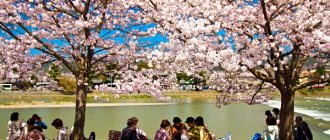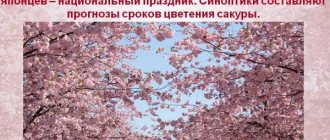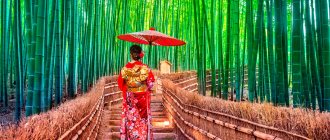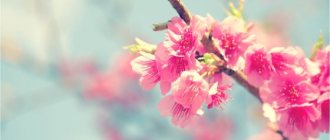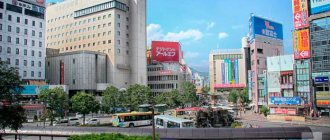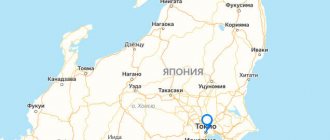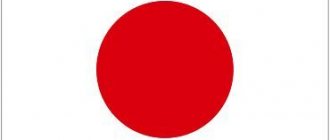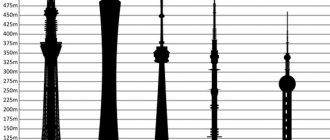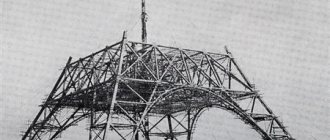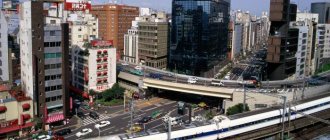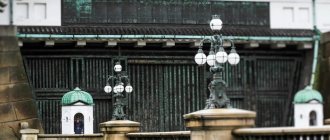WHEN SAKURA BLOWERS IN JAPAN
Due to huge public interest, the National Meteorological Agency of Japan, during the cherry blossom season, in addition to the usual forecasts, talks about the beginning and stages of flowering of Japanese cherry trees in various regions of the country.
Flowering usually begins in late January-early February in Okinawa, then moving with spring to northern Japan. At the beginning of April there is a full blossom on the islands of Kyushu and Shikoku, at the end of March sakura blooms in Tokyo, in the first ten days of April - in Kyoto and Osaka, in Sakiminato and Matsue - in mid-April. By the beginning of May, the wave of cherry blossoms reaches the island of Hokkaido, the cities of Hakodate and Sapporo.
The whole country is watching the movement of sakura to the north. On TV, after the weather forecast, they will definitely say where the sakura is already blooming in full swing, and where it will bloom any day now.
We will also follow Sakura together with you and our tourists who go on cruises around Japan this spring.
Cost of cherry blossom tours
When cherry blossoms bloom in Japan, tour operators organize group and individual tours from all over the world. The cost of travel (flight and hotel accommodation) during cherry blossoms is higher than at other times of the year due to the large influx of tourists.
The choice of cities for the tour is determined by the unpredictability of the beginning and end of cherry blossoms.
Therefore, cherry blossom tours run from mid-March to the end of April, starting from Tokyo and moving around the country towards Osaka. The base cities on any tour are: Tokyo and Kyoto. Cherry blossom viewing takes place in the city where cherry blossoms bloom upon arrival in Japan. During the tour, you will also explore other sights of Japan along the way.
VIP Tour "Sakura"
Duration of the tour is 12 days in a mini-group of 6 people. The cost of a hotel room (Marunouchi Hotel Tokyo 5*, New Otani Hotel Osaka 5*, Hakone Kowakien Tenyu 5*) with breakfast starts from $6900. The tour price does not include flight costs, incidental expenses, or meals not specified in the stay program.
The price includes: 2 dinners at the ryokan, 9 excursions, travel by high-speed train. The tour price also includes entrance fees, transfer from the airport to the hotel and back.
The tour includes visits to the following cities:
- Tokyo;
- Yokohama;
- Kamakura;
- Hakone;
- Osaka;
- Himeiji;
- Kyoto;
- Nara;
- Osaka;
- Miyajima.
Tour “Early Sakura” (economy)
Duration of the tour is 8 days. Requirements for the number of participants: minimum 1 person. The cost of a hotel room (Hotel Lumiere Kasai 3*, Hotel WBF Gojo Omiya 3*, Hotel Ann Asakusa 3*) without breakfast starts from $1950. The tour price does not include flight costs or incidental expenses.
The payment includes: services of a Russian-speaking guide, 4 lunches, 4 excursions, travel by minibus. The tour price also includes entrance fees, transfer from the airport to the hotel and back.
The tour includes visits to the following cities:
- Tokyo;
- Kamakura;
- Kyoto;
- Nara;
Cherry blossom tour (Optima)
Duration of the tour is 11 days. Requirements for the number of participants: minimum 1 person. The cost of a hotel room (Hotel Bande DaBan 3*, Hotel Sunroute Hiroshima 3*, Hotel Keihan Tsukiji Ginza Grande 4*, Nagoya Prince Hotel Sky Tower 4*) with breakfast starts from $3,350.
The tour price does not include flight costs, incidental expenses and food costs not included in the program. The payment includes: services of a Russian-speaking guide, 8 lunches, 8 excursions, travel by high-speed train. The tour price also includes entrance fees.
The tour includes visits to the following cities:
- Tokyo;
- Nagoya;
- Kyoto;
- Nara;
- Osaka;
- Himeizi;
- Hiroshima.
The most beautiful parks in Tokyo to admire cherry blossoms
Tokyo Midtown
When talking about any trip to Tokyo, especially on foot, it is worth mentioning Tokyo Downtown. This also applies to the Cherry Blossom Festival. Tokyo Midtown has a lot to see during this time. This central region around the capital Roppongi is a great place to join the Hanami tradition.
Here you have an alley two hundred meters long, which is planted with sakura trees on both sides. The Ritz-Carlton also hosts many interesting and stylish events. Unwind with a glass of rosé in the Chandon Blossom lounge. The soul will “sing” with this addition to leisure time and admiring the cherry trees illuminated in the late evening. Here you can enjoy the cherry blossom festival until the very last day.
Shinjuku Gehen
The park is located around two lakes. The lakes have islands connected by graceful bridges. In addition to the classic Japanese park, Shinjuku Gehen has French and English style parks.
Although there is a fee to enter, which is around 200 yen, it is worth it. There are about a thousand cherry trees of various varieties in Shinjuku Gehen. Among them are numerous early and late flowering trees. There are large lawns for picnics in a relaxed atmosphere. This is a great place to admire the cherry blossoms for those who have been missing spring.
Ueno Park
Admission to Ueno Park is free. This park is busiest during the Cherry Blossom Festival. Therefore, Ueno Park is the noisiest and busiest place where it is impossible to be alone with your high thoughts, as is suggested to be done in accordance with Hanami.
But this park is truly a wonderful place. There are more than 1000 trees in the park. They line the street that leads to the National Museum and around Lake Shinobazu. Sakura trees here begin to bloom a couple of days earlier than other parks and squares in Tokyo.
Shiba Park
There are only about 70 cherry trees in this small park. But it has its own characteristics that make this place important and worth attention. During the Cherry Blossom Festival, people come there to admire the cherry blossoms and join in the Hanami tradition, just like in other Tokyo parks.
What sets Shiba Park apart from the rest is that the Tokyo Tower is located nearby and graces the landscape. Since this is Tokyo's main observation deck, you can also go there to watch the cherry blossoms.
The height of the tower is 333 meters, which offers truly beautiful views. In addition, the tower has two observation decks. The first is at an altitude of 150 meters. It is considered the main one. The second is 100 meters higher. This is a special observation deck. From here you can see Mount Fuji, the Southern Alps, and the Boso Hanto Mountains. Of course, if the weather is favorable and the sky is clear.
Chidorigafuchi Park
Entry is also free. Numerous cherry trees decorate the canals of Edo Castle and Kitanomaru Park. Chidorigafuchi is a great place to join the Hanami tradition.
The main difference between the park is the ability to rent a boat and enjoy both Hanami and walking on the water. The place can rightfully claim to be the ideal place for a date. Almost 300 trees were planted there. Together they form real clouds that float above the water.
Also, people who come to enjoy the cherry blossoms can do so by simply walking along the path to the pier. It is “immersed” in flowers and offers stunning views.
Excursions during cherry blossoms
When sakura blooms in Japan, excursions to palaces are held in Tokyo, which are usually surrounded by sakura gardens.
They are:
- Imperial Palace. The palace complex covers an area of 7.5 m². The cherry blossom viewing ceremony takes place in Kitanomaru Park. Address: Chiyoda, 1-1. Take the subway to Tokyo Station. The park is open to visitors every day from 10:00 to 15:00, except Monday and Friday. Entrance to the park is free (using a token, which is issued at the entrance and returned upon exit). Those wishing to visit the courtyard register for a visit in advance on the website of the Imperial Palace Management. Tours are held from 10-00 and 13-00 twice a day from Monday to Friday.
- Koishikawa Korakuen Garden . The oldest park in Tokyo (Edo period). In addition to sakura, ponds, miniature bridges, ponds, stones, and reliefs attract attention in the park. Visiting the park is free. Park opening hours are from 9:00 to 17:00 from Tuesday to Friday. Entrance to the park is only until 16-30.
- Ueno Park . Cherry blossoms have been admired in the old park since the Edo period. In the park you can try the popular Japanese delicacy “sakura mochi” - sweet rice balls, painted pink to match the color of sakura, stuffed with red beans.
- Cruise on the Sumida River . Admiring the cherry blossoms growing along the banks of the Sumida River during a cruise is very popular among tourists. Duration of the excursion is 5 hours. The cruise price includes dinner and a drink order. The cost of participation in the cruise is 13,000 rubles.
In Kyoto (the ancient capital of Japan), lush cherry blossoms can be seen in the gardens of temple complexes:
- Ninna-ji Temple Complex. The sakura garden in the temple complex is a favorite place for sakura viewing among residents and guests of the city. Entrance to the garden costs 500 yen. To view the entire complex along the way, buy a ticket costing 1,500 yen. The main attraction of the complex is the statue of Amida Buddha. The ticket price includes a tour of the five-tiered pagoda and the Golden Temple.
- Daigo-ji Temple Complex . After relaxing under the branches of cherry blossoms, you can visit the sights of the complex. The national treasures of the complex include: the Yakushido Hall, the Seiryugu-haide Hall, and the five-tiered pagoda (the oldest building in Kyoto). General admission costs 100 yen.
- Hirano-jinja Sakura Shrine . Sakura trees have been planted here since the Heian era (period of peace from 794 to 1185), planting trees symbolized the strengthening of peace and vitality. Today, the sanctuary has 400 cherry trees of 60 different varieties. There are species that bloom in October. The area for Hanami is being set up at the shrine: benches are installed, lanterns are hung. Food and souvenirs are sold. The entrance is free.
- Gion Park . Hanami Park goes on all day and all night. The attraction of the park is the weeping sakura - a large tree in the center on a hill. The park can be found just behind Yasaka-jija Shrine. Entrance to the park is free.
Meguro River
The cherry blossoms along the small Meguro River, near the Naka-Meguro area, are an impressive natural spectacle. In the third ten days of March and the first ten days of April, the alleys are specially illuminated for night walks and admiring the cherry blossoms.
Hanami Festival in Tokyo, Meguro River
Opening hours and prices:
Cherry blossoms over the Meguro River are a public attraction, this place is open 24 hours a day, visiting is absolutely free.
How to get there:
First you need to get to JR Meguro Station, and then walk along the river bed to Nakameguro Station.
The beginning of cherry blossoms in Tokyo
Book a hotel in Tokyo
Japan's pink fairy tale: exclusive report from Tokyo
Hanami - a holiday of admiring flowers - is a unique phenomenon for the modern bustling world. For several days, a huge number of people specially set aside time to contemplate the beautiful natural phenomenon. Short, fleeting, which you definitely need to have time to enjoy.
Especially for readers of the Masters Fair Magazine, our compatriot Svetlana, who has been living in the very heart of Japan for several years - in Tokyo - talks about this amazing tradition and shares beautiful views of cherry blossoms.
“Now everyone who is in Japan is triumphant in their souls - cherry blossoms are blooming and the spirit of spring is in the air everywhere. For the Japanese, every detail of each season is very important, because sakura is a beautiful, but quickly ending joy, so to speak, a gift of spring. Therefore, everyone tries to accept this gift with gratitude, be sure to find time to admire these beautiful little flowers, if possible, photograph them and fill your heart with the warmth that this magical time brings, and save these feelings until next year.”
“For the Japanese, sakura is important precisely because it is a cute, small flower whose life is very short, but which carries great meaning. They generally treat plants with care, in winter they dress trees in cute clothes so that they don’t freeze, and there are flowers near almost every house. If someone has a garden, then it is a well-groomed garden into which its owner puts his soul, effort and resources. There are a large number of parks here. And it certainly doesn’t occur to anyone, as happens in Russia, to break branches home)))”
“Now the stores are filled with everything related to the smell of cherry, which carries the aroma of sakura. Restaurants serve pink desserts, in the shape of small pink flowers, or with a small branch of sakura attached.”
Before and during cherry blossoms, all media - television, newspapers, radio - prepare colorful forecasts and reports about cherry blossoms. The meteorological agency is responsible for forecasting.
This is what the cherry blossom calendar map for 2013 looks like. It begins to bloom, which is understandable, in the South from the third decade of March, and this magical fairy tale ends at the end of April in the northern part of the country:
“6 years ago I happened to find a hanami in Kamakura - this is an ancient town near the sea, once upon a time, during the times of the samurai, it was even the capital. There, combined with the truly Japanese style, sakura looks amazing. Calmness is one of the characteristic features of the Japanese, so in a calm environment, without a huge number of picnics, sakura looks most natural and majestic."
Sakura admiration is a mass phenomenon. Fun, picnics, snacks and drinks are typical. “That year I was at a hanami near a small river in Yokohama, there were a lot of small stalls where you can find different goodies, and a lot of people - you had to wait a long time to sit down somewhere.”
“In general, a place in the park is occupied approximately 1-2 days before the picnic. And if a picnic is organized by a kaisha (company), then the youngest employee is sent, who sits there for one or two days (depending on the place) and guards this place so that no one takes it. There is no official day off on the occasion of hanami, but many companies organize something like a corporate event in the park, and on this day they do not work, but have fun in the open air with their colleagues.”
“On the occasion of the holiday, snack stalls offer visitors “hanami dango” - three sweet rice balls on a stick.”
You can try to prepare these sweets yourself: to do this, you need to gradually mix rice flour with warm water in a ratio of 200 g of flour and 140 ml of water. Add a little sugar. To make tri-colored dangos, as in the photo, the Japanese color the dough - for pink they add red azuki bean paste, and for green - a local variety of wormwood or green tea. You should get a smooth soft dough. Form the dough into walnut-sized balls and place them in boiling water. After the dangos have floated to the surface, cook them for another 3 minutes, then take them out and immerse them in cold water. Once the dangos have cooled, you can thread them onto skewers.
“It’s nice to admire sakura from the water while walking on a catamaran”
“I like it when the sakura is already falling off when the wind blows. It looks like a light snowfall. A particularly beautiful sight is sakura at night. Many people specially visit the park at this time to enjoy a truly fabulous spectacle - the trees are illuminated from below, and sakura can take on a variety of shades, but at the same time does not lose its naturalness and splendor.”
There are countless songs dedicated to sakura and hanami in Japan. Here, for example, are lines from a Japanese folk song about sakura, written back in the Edo era (in the 17th century):
| Sakura sakura Noyama mo sato mo Miwatasu kagiri Kasumi ka kumo ka Asahi ni niou Sakura sakura Hana zakari Sakura sakura Yayoi no sora wa Miwatasu kagiri Kasumi ka kumo ka Nioi zō izuri Izaya izaya Mi ni yukan | Sakura, sakura... And mountains, and villages - Wherever you look, Either fog, or a cloud Smells fragrant under the morning sun. Sakura, sakura In full bloom. Sakura, sakura... In the April sky, Wherever you look, It’s either fog or a cloud. Oh, what a scent!.. Let's go, let's go, Let's see! |
“By the way, for many Japanese, hanami is not only a celebration of beauty, but also a pleasant realization that spring has come, the long school year has ended and the long-awaited two-week holiday is coming)))”
Enjoy the gifts of nature, admire its beauty, strength and grandeur. Take the time to contemplate all the beauty that surrounds us every day and the wisdom to notice it.
Photo: personal archive of Svetlana Kotenkova; Internet sites Publication within the framework of the theme week Japan >>
The tradition of admiring sakura
In Japan, there is a traditional viewing of cherry blossoms in the spring. It is called Khanami and appeared at the imperial court. The courtiers sat for a long time in the cherry orchards, not only looking at their beauty, but also having picnics with games and writing poetry.
In spring, with the appearance of sakura flowers, parks, squares, alleys, as well as the territories of Buddhist and Shinto temples with cherry blossoms are visited by many people. Today it is a kind of holiday not only for the Japanese, who follow their traditions, but also for many visiting tourists.
The Japanese treat their parks with the utmost respect, and expect visiting tourists to do the same. Each Japanese park has its own rules for visiting. For example, you should not pick sakura flowers, climb trees or shake branches. Many parks prohibit fires, including campfires. And, of course, you must clean up your trash.
